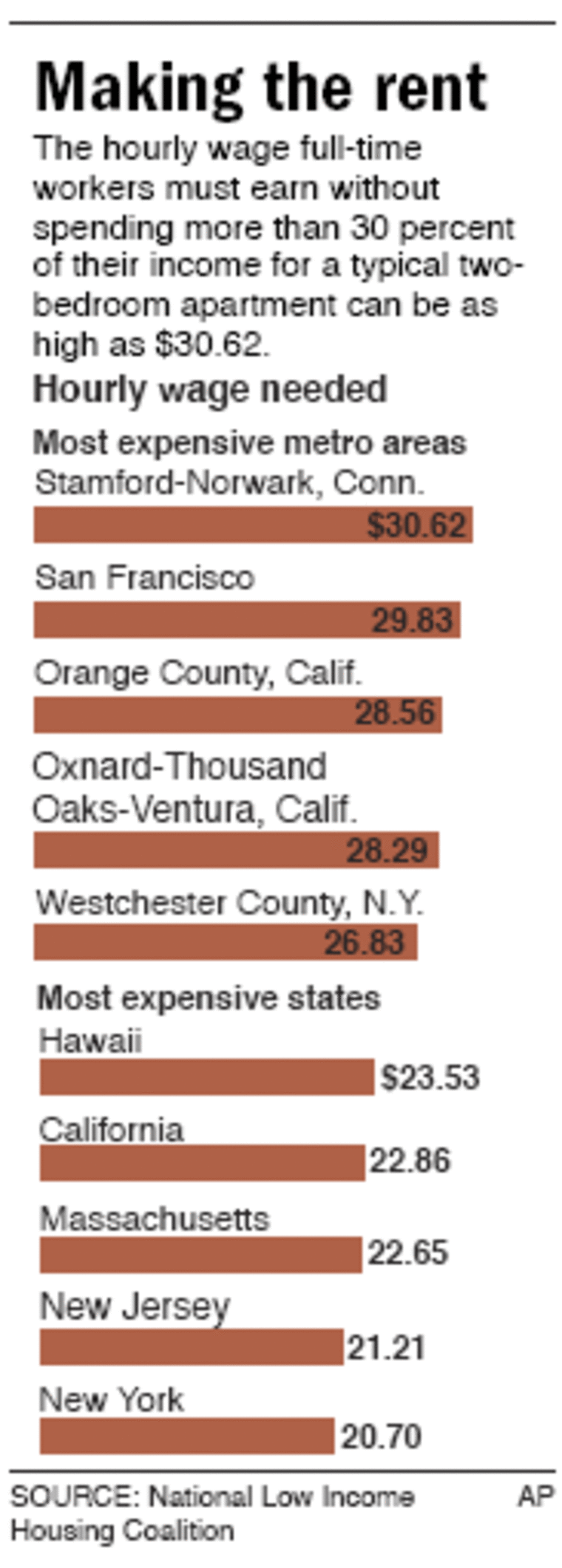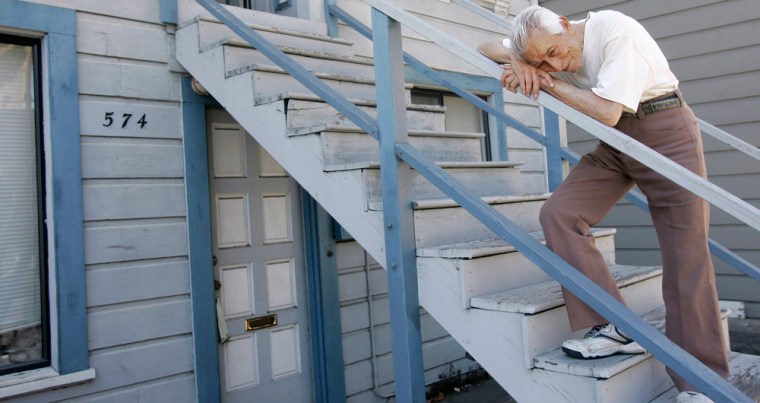This isn't how Simon and Jennifer Morris envisioned married life — sharing a charity-subsidized suite with four other hard-up families, abiding by a curfew and other rules that make them feel they are back in high school.
But for a working-class couple with two small children, trying to stick it out in their pricey hometown, housing options are few.
They abandoned their previous one-bedroom apartment when the rent rose from $1,200 to $1,425. Public housing has long waiting lists, so they moved into a shelter for dislocated families in a converted YMCA. The goal: Save enough money to move south and buy a home where costs are lower.
Around them, southwestern Connecticut's Fairfield County is booming, due partly to an influx of investment banks. New housing projects routinely cater to the affluent.
"But everybody forgets the poor guy — the one who pumps your gas, who builds your hotel, who bags your groceries," said Simon Morris, a 35-year-old carpenter. "The cost of living is driving us out."
On both coasts of the United States, and many cities in between, hundreds of thousands of renters face comparable plights. The home mortgage crisis has received far more notice, but experts say the ranks of renters with dire housing problems are growing faster than the ranks of defaulting homeowners.
The Center for Housing Policy reports that the number of working-family renters paying more than half their income for housing has soared from 1 million to 2.1 million since 1997. Overall, advocacy groups say there are 9 million low-income renter households and only 6.2 million units they can reasonably afford.

"These people spend huge portions of their income on their housing," said Sheila Crowley, president of the National Low Income Housing Coalition. "They don't do things that we all would like to do — save money to buy a house, or for college or retirement. It's a very day-to-day existence."
In the Stamford area, a breadwinner needs to earn more than $30 an hour to afford the rent of a typical two-bedroom apartment, the highest figure in the nation. San Francisco ranks a close second — placing immense burdens on residents such as schoolteacher Meagan Devine and retiree Jose Morales.
Devine, 30, lives with her sister, who is eight months pregnant, and brother-in-law in a one-bedroom apartment in San Francisco's Sunset district. She sleeps on the couch and spends weekends at her parents' house in a distant suburb, where she keeps her clothes and books.
In October, she'll begin housesitting for family friends in Berkeley, who will be on sabbatical until Jan. 1. After that? She isn't sure.
Devine isn't an itinerant hippie or recent college grad trying to map a career path. She's a professional with a master's degree in math, and could likely command a six-figure salary at a Silicon Valley engineering firm.
But since college, she has yearned to be a teacher. After getting her master's, she taught the children of crop pickers.
Since 2002, she's been a math instructor at Balboa High School, once a hardscrabble school on the city's south side. Test scores and morale are on the rise, and Devine feels she's making a big difference by teaching pre-calculus and algebra to the diverse student body.
"I don't ever want to leave Balboa — I'd love to retire from here," Devine said as she stacked papers following the afternoon bell. "The only problem is I can't afford to live here on a teacher's salary."
After taxes and a $350 deposit into a retirement fund, she takes home about $2,500 per month. One-bedroom apartments in desirable neighborhoods — near friends and public transit — start around $2,000 per month. Studios start around $1,500.
Devine said she'll likely settle for roommates — a fate she didn't envision for herself after college, and a far cry from her dream of home ownership.
Technically, she could afford her own modest apartment — but she wants to heed the standard advice and not spend more than a third of her income on housing. That's not easy; experts say nearly a quarter of San Francisco renters spend more than 50 percent of their household earnings on rent, and the market has grown tighter as the mortgage crisis deters some young adults from home-buying.
Devine rarely goes out to eat or buys new clothes, but despite a frugal lifestyle has been unable to whittle down $3,000 in credit card debt.
"You have to make big sacrifices — not just whether to buy a house or not," said Devine. "I want to have kids — but what would I do with them? I can't even afford my own place."
Devine works at least 50 hours a week, including several hours each weekend grading quizzes. Some of her colleagues moonlight as waitresses, bartenders and weekend nannies.
One option would be moving to a suburban school district, where pay scales range up to $10,000 higher than in San Francisco. A public school teacher in the city starts at $43,000.
Losing teachers like Devine should be a top concern for residents, said Matthew Hardy of the United Educators San Francisco. Teachers who stay have to be either "crazy or dedicated," he said.
Jose Morales, now 78, moved into a modest Victorian house in San Francisco's working-class Mission District in 1965, shortly after emigrating from Peru. The rent was $80 a month, and he used leftover earnings to travel, buy nice clothes and eat well.
The rent is now $864 — a bargain by local standards but an unmanageable fortune for Morales. A former tennis instructor, he hurt his back last year and now relies entirely on a Social Security payment of $900 per month.
After paying the rent, he has $36 a month for expenses, including food and medications. He eats at city-sponsored senior centers, which charge $1.50 per meal, buys cut-rate produce from local bodegas and takes freebies from friends.
He never travels. He doesn't own a television or radio. Among his few new clothes are tennis sweat shirts that pro shops sell him at a discount.
"I'm skin and bones — it's a miracle I'm still here," said Morales, who's lost 20 pounds since last year and developed osteoporosis.
Stooped but sinewy, with wavy white hair and vintage Wilson sneakers, Morales has received numerous eviction notices from a landlord hoping to convert the two-unit flat into a luxury house. Morales refuses to leave; a court showdown is imminent.
"If more people don't try to fight for their rights, then only rich people would live in this city," he says.
Morales' apartment is ramshackle. Door frames lean at improbable angles. Paint peels from walls, and a gaping crack splits the kitchen ceiling.
But the beautifully restored Victorian next door has golden cornices and fresh paint, and other nearby homes are getting high-end renovations. The neighborhood is rife with homeless people and illegal immigrants, but white-collar workers are moving in to commute to lucrative jobs in Silicon Valley or downtown.
Morales knows he might live better in Peru, where relatives could help and the cost of living is a fraction of California's. But that would end his quest for American citizenship.
"I came here because the U.S. was a great country," Morales said. "But housing has become a big injustice. ... The story of my apartment is the story of my block and the story of my city and the story of all of California and the United States. You have to fight for it, and that's what I will do — all the way to the end."
Back in Stamford, Simon and Jennifer Morris have seen the city's economic boom firsthand but, like many working-class families, haven't shared its fruits.
Simon has irregular earnings as a carpenter; he can make $1,000 in a good week but often has no work at all. Jennifer, 27, worked in the past at local pet stores, but took time off this year following the birth of Layla, who's now 7 months old. Their other child, Ethan, is 3.
Since February, they've been living in a "family emergency" shelter on the edge of downtown, part of a multipurpose social-service center run by St. Luke's LifeWorks.
They have two bedrooms of their own, but share bathrooms and a combination kitchen-common room with four other families in a setup resembling a college dorm. There's an 11 p.m. curfew on weeknights, no drinking or smoking in the unit, and a rotation of chores for each family.
"After living on your own, where you can come and go, you can feel a little claustrophobic," Jennifer said. "You've got to coexist with everyone. Sometimes I feel like I'm back in high school."
For Simon, the biggest downside is lack of privacy.
"There's good days and bad days," he said. "People notice when I'm grumpy, and sometimes I just want to be left alone."
But overall, the Morrises are grateful. They can stay up to two years at the shelter, far longer than at many similar facilities, and they expect to be able to save money — for the first time in their married life — due to a cost-sharing formula which leaves them paying St. Luke's about $250 a month.
If the savings materialize, they plan to head south, seeking a community where homes are within reach of a family like theirs.
"Stamford forgot about the poor people," said Simon, who, like his wife, grew up here. "All these new apartments are great for the city, but some of the one-bedrooms are $3,000 a month. ... It's a businessman's town now."
The executive director of St. Luke's LifeWorks, the Rev. Dick Schuster, says Stamford and boomtowns like it should tackle the housing crisis out of self-interest.
"The people who are working in your restaurants, your fire and police departments, are all of a sudden finding they can no longer afford to live in the community where they work," he said. "And those who do choose to live in the community become the true working poor, hanging on by their thumbs."
